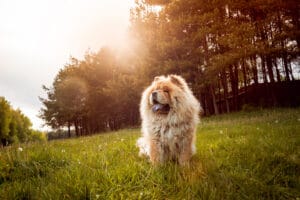While Chow Chows are said to be very intelligent, they can also be extremely stubborn and very independent. This can make training a Chow a challenge for impatient or inexperienced dog owners.
Patience and consistency are very important when training a Chow Chow. They are generally very eager to learn and are smart enough to quickly pick up on almost anything. However, their independent and stubborn side may keep you on your toes when trying to keep a Chow focused on the task at hand.
Puppy training should start as early as 8 weeks old, with even younger puppies being exposed to many different sights and sounds in their environment so they are well-rounded and don’t shy away from new experiences.
Chow Chows are said to be very clean dogs, and their somewhat snobby attitude has been likened to that of a cat. Because of this haughty disposition, Chows are extremely easy to housetrain and do amazingly well with crate training.
When using a crate, always keep in mind that it should not be used as a jail cell for punishment. It’s a safe haven for your Chow to relax and retreat to if household actions are getting too active for his liking.
Puppy Training & Socialization
As soon as you bring your new Chow Chow puppy home, socialization should start. This can be as simple as exposing your new puppy to other members of the family, including other pets, as well as introducing him to new or strange sounds on a daily basis.
Puppy training classes from the age of 8 weeks onward are an excellent option as well and can be used to form the groundwork of basic commands such as sit or stay. Even with adequate training, Chow Chows are naturally suspicious of visitors and will need to follow your guidance on who is accepted in your home and who is not. Always greet visitors happily and your Chow will be tolerant of their appearance too.
Being a thick-jawed Spitz-type breed, a Chow Chow has a very strong bite. Training your puppy to play gently and not to bite when playing can be important. Positive reinforcement is just as important as being patient and consistent in your training.
What might be cute as a puppy can be destructive and unwanted behaviour as an adult – but by then, correcting that behaviour is much more difficult. Always teach your puppy early how to be a well-mannered and confident companion to you and your family.
Possessive Side
Chow Chows are known to have a possessive side. This is normally seen as “resource guarding” when it comes to food, treats or toys. Some Chows might not be happy if their favourite toy is taken away or if it seems like someone is attempting to take their food. This may be from another pet, or even a human child.
Some dog behaviourists see this as a ranking status within the family more than a dominance issue. Your dog should be a part of the family, not the leader of it. If you notice dominant or possessive behaviour as a puppy, use distraction tactics or other training methods to correct the behaviour. Contacting a dog behaviourist or puppy trainer in your area can help nip this potential issue in the bud.







